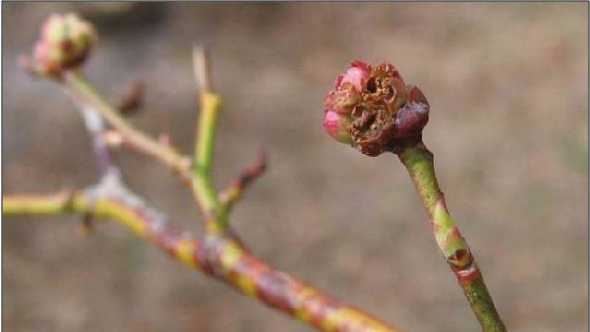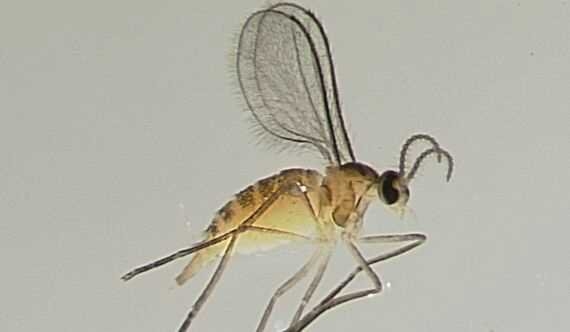Several Florida blueberry growers have recently reported flower bud damage and corresponding fruit loss, in some cases up to 50% on certain affected cultivars. These reports have focused primarily on Emerald, Farthing and Meadowlark, although other cultivars may have also been affected to some degree. There could be multiple reasons for flower bud damage and the resulting fruit loss, including hydrogen cyanamide and freeze damage. However, in several cases this year it is believed that this type of damage has been caused by blueberry gall midge.
High populations of blueberry gall midge in blueberry can result in significant flower bud injury and reduce fruit set and yield. Females lay eggs in floral and vegetative buds just after bud swell. Gall midge larvae then feed on developing leaf and floral buds. Affected floral buds develop a dry, shriveled appearance and will often disintegrate (Figure 1). Damaged leaf buds are characterized by misshapen leaves and blackened and distorted shoot tips (Figure 2). When the terminal bud on a shoot is injured or killed, shoot elongation growth may be inhibited with excessive later branching occurring just below the damage terminal bud. Weather may impact the density of gall midge populations, with warmer temperatures > 60o F resulting in early emergence. Furthermore, re-infestation of previously infested areas is common if management action is not taken when gall midge injury is observed.
Growers should be aware of the possibility of gall midge damage in their fields this season, resulting in floral bud death and lower fruit set. Dr. Oscar Liburd, University of Florida blueberry entomologist, is preparing a bulletin to be released very soon with current gall midge management recommendations to be implemented after this season's harvest is complete. Until this extension bulletin is ready to be published, growers can view pesticide recommendations for gall midge in The Blueberry News magazine.
High populations of blueberry gall midge can result in significant flower bud injury and reduce fruit set and yield, Phillips points out. The following are his scouting tips for this pest.

Blueberry gall midge bud damage
Photo by Craig Roubos
- Females lay eggs in floral and vegetative buds just after bud swell. Gall midge larvae then feed on developing leaf and floral buds. Affected floral buds develop a dry, shriveled appearance and will often disintegrate.

Symptoms of blueberry gall midge leaf damage
Photo by Craig Roubos
- Damaged leaf buds are characterized by misshapen leaves and blackened and distorted shoot tips. When the terminal bud on a shoot is injured or killed, shoot elongation growth may be inhibited with excessive later branching occurring just below the damage terminal bud. Weather may impact the density of gall midge populations, with warmer temperatures (greater than 60°F) resulting in early emergence. Furthermore, re-infestation of previously infested areas is common if management action is not taken when gall midge injury is observed.
Is this something that California growers should be concerned about? To my knowledge these midges have not been reported in California. We also don't use hydrogen cyanamide which may be contributing to the problem. With plant material and people moving around, though, it might show up and be a problem. I never thought blueberry rust would show up in California, but as the crop has become more widespread, it has showed up. Ever alert.
Alert from UF/IFAS Blueberry Extension Coordinator Doug Phillips:
http://entnemdept.ufl.edu/creatures/fruit/blueberry_gall_midge.htm
https://pubag.nal.usda.gov/download/10784/PDF
Photo: Blueberry Gall Midge, Dasineura oxycoccana
Attached Images:
